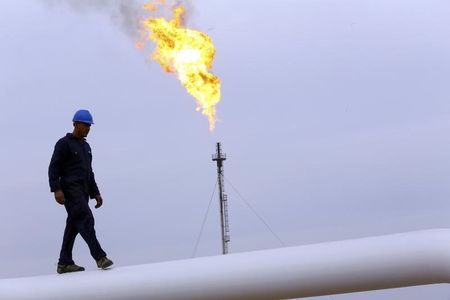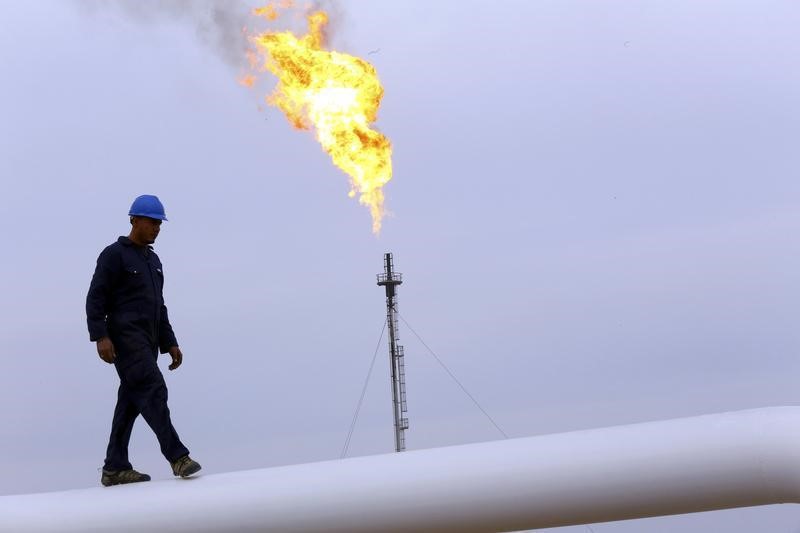Commodities
Oil tumbles on risk aversion as Q4 starts; bulls look to OPEC


© Reuters.
Investing.com – No market operates in a vacuum — including oil, no matter what the proponents of higher crude prices think.
Worries that inflation will rear its ugly head again to suppress demand in almost everything set off a wave of risk aversion on Monday that handed global markets an ominous start to the fourth quarter.
The surge to a new 10-month high added to the weight of commodities denominated in the U.S. currency. The dollar shot up as a number of policy-makers at the Federal Reserve hinted on Tuesday at another rate hike in either November or December to keep under control and nearer to the central bank’s 2% per annum target from a current 3.7%.
On the crude oil front, New York-traded West Texas Intermediate, or WTI, and London’s Brent fell about 2% each, extending losses from Friday. The two crude benchmarks had risen nearly 30% in the third quarter, threatening a new round of chaos to economies in non-oil producing countries.
While September manufacturing data, via the , improved in both the United States and Europe, economists saw that as more of a work-off on inventories of raw materials in hold. The concern is how the global economy would fare for the rest of 2023 if energy prices continue rising without control, adding an onerous burden to overheads.
“The damage that can be done to the economy by high oil prices is very real and it’s completely delusional to think this is acceptable for the bulk of the world which does not produce oil but instead consumes it,” said John Kilduff, partner at New York energy hedge fund Again Capital.
for delivery in November settled at $88.82 — below the key $90 per barrel mark — after sliding $1.97, or 2.2%, on the day. The U.S. crude benchmark hit a three-week low of $88.47 earlier.
for the most-active December contract settled at $90.71, down $1.49 cents or 1.6%. The global crude benchmark plunged to $90.36 earlier.
On the brighter side of oil, OPEC+, the 23-nation alliance of oil producers, is to meet on Wednesday. The proponents of higher crude prices are counting on OPEC+ — which groups the 13-member Saudi-led Organization of the Petroleum Exporting Countries with 10 independent oil producers steered by Russia — to reignite the upward momentum held by the market over the past four months.
But sources within OPEC+, speaking privately to media, said the alliance is unlikely to tweak production targets for November and December.
The Saudis and Russians pledged last month to cut at least 1.3 million barrels per day of their regular production until the end of the year, in what many believe was a bid to bring crude back to $100 a barrel or more. U.S. crude went from lows of beneath $64 a barrel in May to above $95 in September, while global benchmark rallied from below $72 to above $97 in the same span.
At the same time, OPEC+ may have paid a different “price” for such action.
Asia’s crude oil imports slipped for a second consecutive month in September as refinery maintenance trimmed demand and the impact of higher prices started to weigh, Reuters reported, citing LSEG data.
The world’s top importing region saw arrivals of 24.95 million barrels per day in September, down from August’s 25.22 million, according to LSEG.
Saudi Arabia and Russia are also anticipating an array of different challenges for the October-December stretch that could make a repeat of their third-quarter market performance difficult.
Notwithstanding the view that OPEC+ might not make changes to its production, pressure appears to be building on the Saudis and Russians to ease back on some of their output cuts in order to have adequate oil for cargoes scheduled for year-end delivery.
There is also the notion, especially among the Saudis, that they need to protect market share for their oil with the current high prices for a barrel that expose them to risk of under-cutting by their allies, including the Russians.
Already, India’s imports of Saudi oil were at below 500,000 barrels per day in September — the lowest in almost a decade.
Mixed Chinese data
On China, ING’s energy analysts observed in a note that while Chinese manufacturing PMI returned to expansion territory in September for the first time since March, “the Saudis have said that there is still concern over Chinese demand”.
Official data on Saturday showed that China’s factory activity expanded for the first time in six months in September, adding to a run of indicators suggesting the world’s second-largest economy has begun to stabilize.
However, a private-sector survey on Sunday was less encouraging, showing the country’s factory activity expanded at a slower pace in September.
Indeed, a durable recovery in China’s economy is being delayed by a property slump, falling exports and high youth unemployment, raising fears of weaker fuel demand.
Saudis might need to produce more oil, not less
Thus, the Saudis might need to produce more in October — not the same of what they pumped in September and certainly not less — to keep China, India and other important customers happy.
In fact, crude shipments from Saudi ports likely rose between 300,000 and 400,000 barrels per day last month from August — despite their so-called “lollypop cut” of one million barrels per day — OilPrice.com noted in a roundup of market intelligence gathered from various sources.
And the trend could continue, it said.
The Saudis have also been quite restrained in adding to the Official Selling Price, or OSP, of their crude despite Brent’s runaway rally, that market roundup showed. Saudi Arabia’s medium sour crude grades were hiked by $0.10 per barrel each, moving Arab Light to a $3.60 per barrel premium vs Oman/Dubai. The only Saudi crude grade that saw a notable increase in October was Arab Super Light, a very rare condensate-like grade that sees 1-2 cargoes per month, which rose by $0.50 per barrel.
“In an environment like this, Saudi Arabia’s national oil company Saudi Aramco (TADAWUL:) was expected to hike Asian prices by a solid margin,” the OilPrice roundup said. “Surprisingly, the anticipated OSP increase did not happen.”
“Overall, the lack of pricing ambition reflected wider worries about the health of Chinese demand into the remaining months of 2023, as well as significantly lower Indian nominations lately.”
To Moscow’s benefit, India has begun buying Russian urals crude at around $80 per barrel — markedly higher than the $60 price cap set by the G7, but still lower than the flat price of Brent.
But Russia, which has committed to the Saudi production squeeze plan by announcing a 300,000-barrel per day cut of its own, is also under pressure to keep up with deliveries promised to customers.
Russia seen rolling back on fuel export ban
Moscow recently eased its separate ban on fuel exports introduced to stabilize the domestic market. Analysts do not expect those restrictions to stay for long because they may hit refinery runs and impact relations with customers.
Turkey, Brazil, Morocco, Tunisia and Saudi Arabia were among the main destinations for Russian diesel this year, JPMorgan said in a note.
“(A) protracted export ban would negatively impact the relationship with the new customers that Russian oil companies have so painstakingly built over the last year and a half,” according to JPMorgan.
Even so, Russia has not discussed a possible crude oil supply increase to compensate for Moscow’s fuel exports ban with OPEC+, the Kremlin has said.
That communication might be made directly when the Russians and Saudis hold talks at Wednesday’s OPEC+ meeting.
After having psyched the trade into believing their production cuts could go on indefinitely and against market reality, it would be important for neither side not to publicly admit anything to the contrary and work instead in keeping up the narrative they have created.
Commodities
Oil prices rise; U.S. crude inventories plunge, Russia-Ukraine truce eyed
Commodities
India’s Reliance to stop buying Venezuelan oil over US tariffs, sources say
Commodities
Oil prices climb on Venezuela supply worries

 Forex3 years ago
Forex3 years agoForex Today: the dollar is gaining strength amid gloomy sentiment at the start of the Fed’s week

 Forex3 years ago
Forex3 years agoUnbiased review of Pocket Option broker

 Forex3 years ago
Forex3 years agoDollar to pound sterling exchange rate today: Pound plummeted to its lowest since 1985

 Forex3 years ago
Forex3 years agoHow is the Australian dollar doing today?

 Cryptocurrency3 years ago
Cryptocurrency3 years agoWhat happened in the crypto market – current events today

 World3 years ago
World3 years agoWhy are modern video games an art form?

 Commodities3 years ago
Commodities3 years agoCopper continues to fall in price on expectations of lower demand in China

 Economy3 years ago
Economy3 years agoCrude oil tankers double in price due to EU anti-Russian sanctions























